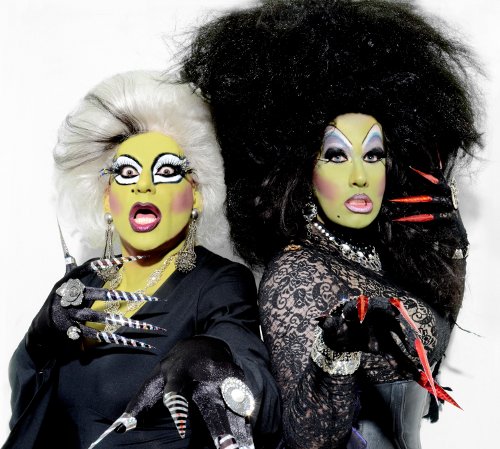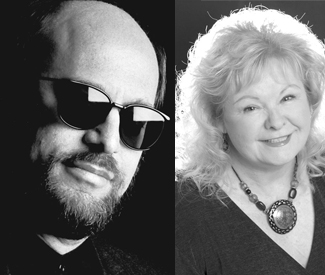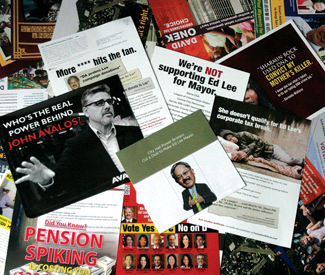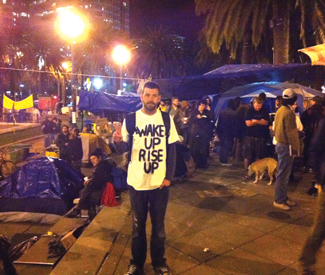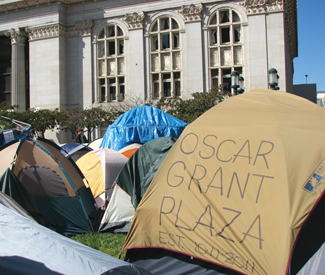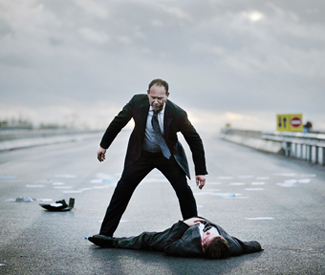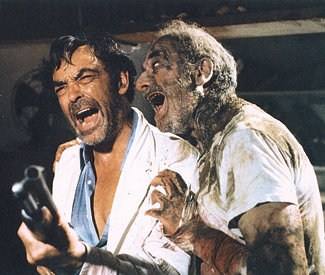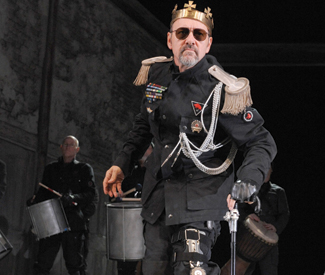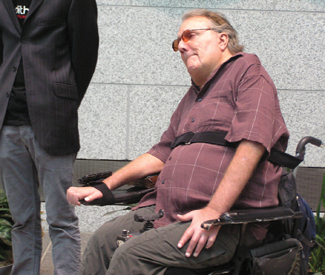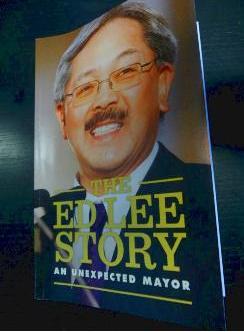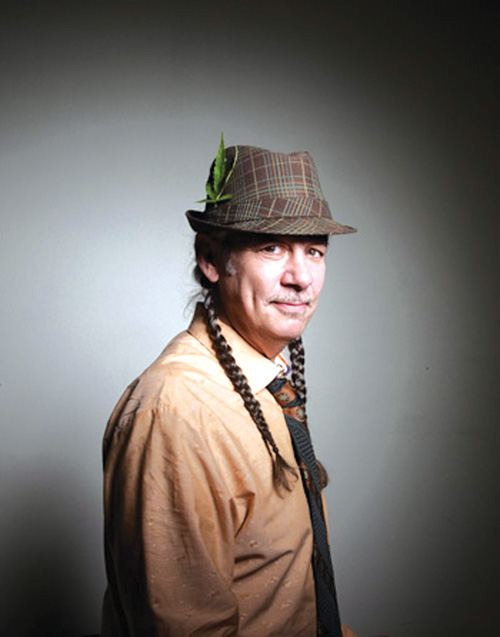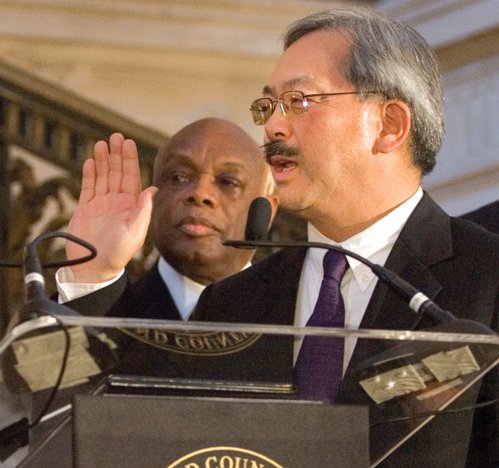culture@sfbg.com
Hell’s bells, our very own high unholy day approaches — and the fact that Halloween’s on a Monday this year means an entire weekend of insane. Oh, why not just make it a whole week. Surely you have a week’s worth of slutty Rick Perry toupee costumes in your closet? Tape ’em on crooked and check out some of the eee-vil events below, from fiendishly family friendly to naughtily “adult.”
WEDNESDAY 26
“Death in Parallel” fundraiser and preview Mission Cultural Center, 2868 Mission, SF. (415)821-1155, www.missionculturalcenter.org. 6:30 p.m.–9:30 p.m., $50. Get your dead on a little early at this sneak preview of the epicenter of SF’s Dia de los Muertos celebration.
Dream Queens Revue: Halloween Spooktacular Show Aunt Charlie’s Lounge, 133 Turk, SF. www.dreamqueensrevue.com. 9:45 p.m., free. The dreamy weekly drag show goes ghoulish with SF’s sole goth queen, Sophilya Leggz.
THURSDAY 27
“Ann Magnuson plays David Bowie and Jobriath, or, the Rock Star as Witch Doctor, Myth Maker, and Ritual Sacrifice San Francisco Museum of Modern Art, 151 Third St., SF. (415) 357-4000, www.sfmoma.org. 6 p.m.-9:45 p.m., free with museum admission. Fierce hero of the 1980s New York performance underground (and familiar face as sitcom television sidekick-boss-neighbor), Magnuson returns to her fabulous roots in this piece that include incorporate “dreams, Jung, human sacrifice, Aztec shamanism, and all things dark, bloody, and beautiful.” And it’s a costume party! In the SF MoMA! Creativity abounds.
“Halloween! The Ballad of Michele Myers” CounterPULSE, 1310 Mission, SF. www.counterpulse.org. 8 p.m., also Fri/28-Sun/30, $20. Gear up for a drag-studded slasher musical taking cues from “Heathers” and “The Facts of Life,” starring the perfectly horrific Raya Light. She’s a-scary!
Naked Girls Reading: Neil Gaiman Center for Sex and Culture, 1349 Mission, SF. www.sexandculture.org. 8 p.m., $15. Costumes and masks are encouraged at this semi-participatory, all-but-traditional reading of Sandman creator Gaiman’s darker work.
TheaterPop SF: SuperNatural, Red Poppy Arthouse, 2698 Folsom, SF. www.redpoppyarthouse.org. 7 p.m., $10. Local performers skip the tacky underchin flashlights and dry ice for carefully composed, intricate explorations of the macabre.
“Unmasked! The 2011 GLBT Historical Society Gala” Green Room, San Francisco War Memorial, 401 Van Ness, SF. www.unmaskedgala.org. 6 p.m.-9 p..m., $60/$100. A star-studded affair featuring fabulous (of course) entertainment, yummy food, and some of the most revered names in the queer community, including Phyllis Lyon, Jose Sarria, and Armistead Maupin.
Zombie Nightlife with Peaches Christ California Academy of Sciences, 55 Music Concourse Dr., Golden Gate Park, SF. www.calacademy.org. 6 p.m.-10 p.m., $12. The undead are by no means unfashionable — get a zombie makeover, dance with similarly festering folks, sample the latest zombie video games, and listen to a presentation by the Zombie Research Society at the ever-popular, always good-looking weekly Nightlife event at the Cal Academy of Sciences. With Peaches Christ as hostess, it’s a zombie no-brainer.
FRIDAY 28
The Big Nasty: 10th Anniversary Party with Too $hort Mezzanine, 444 Jesse, SF. www.mezzaninesf.com. 8 p.m., $30. A $1000 best costume prize is sure to put the kibosh on those perennially popular nurse get-ups. As if legendary Bay legend Boo $hort, er, Too $hort weren’t enough of an incentive to ditch tired costumes and go as your favorite classic rapper.
Haunted Hoedown, Bottom of the Hill, 1233 17th St., SF. www.bottomofthehill.com, 9 p.m., $10. Rin Tin Tiger and Please Do Not Fight headline the second annual hoedown at this live rock showcase; expect a barn-burner.
Jason Webley’s Halloween Spectacular Slim’s, 333 11th St., SF. www.slims-sf.com. 9 p.m., $14. After once faking his own death at a Halloween show and then disappearing for six months, accordionist Webley’s full-band show this year promises excitement, to say the least.
Night of the Living Shred Club Six, 66 Sixth St., SF. www.clubsix1.com. 9 p.m.-4a.m., $10. This hip-hop and electro throwdown is one where we’ll let the WTF press release speak for itself: “four rooms, five bands, five of the Bay’s best DJs including The Whooligan and Richie Panic, a Paradise Wheels half-pipe and best skate trick contest” — all catered by Mission Chinese Food and Bar Crudo and hosted by two of our favorite people ever, Kelly Kate Warren and Parker Day.
“Rhythm of the 90s” Ultimate Halloween Party Café Cocomo, 650 Indiana, SF. www.fivestarunited.com. 9 p.m.-2 a.m., $45. Break out the Clueless costume and the ketchup bottle; Café Cocomo’s massive dance floor has plenty of room to turn back the clock. Macarena, anyone?
Salem 103 Harriet, SF. www.1015.com, 10 p.m., free. The biggest and scariest name in the witch house dance music movement swoops in from Michigan for a free show, with Tearist, Pfang, Gummybear, Dials and Whitch providing gallows support.
Scaregrove, Stern Grove, 2750 19th Ave., SF. www.sfrecpark.org. 4 p.m.-9 p.m., $8. ‘Tis the season for bouncy castles — bring the kids out for hayrides, carnival activities, a haunted house, and (fingers crossed) funnel cake at the park.
Speakeasy’s Monsters of Rock Halloween Festival Speakeasy Ales and Lagers, 1195 Evans, SF. www.goodbeer.com. 4 p.m.-9 p.m., free. Parties centered upon the theme of good beer never really get old — especially when there are food trucks, live music, and heady costumes.
Sugar Skull Decorating Workshop Autumn Express, 2071 Mission, SF. www.autumnexpress.com. 5 p.m.–6 p.m., $20. Sugar skulls are provided (so you can keep licking away at last year’s) at artist Michele Simon’s decorative exploration of the Dia de los Muertos tradition.
Third Annual Zombie Prom Verdi Club, 2424 Mariposa, SF. www.zombiepromsf.com. 9 p.m., $20. Costume contest, coffin photo booth, live music, and a scary thought: the dancers on the floor tonight may have been doing that move for hundreds of years. Hey, our prom was kind of like night of the living dead, too.
SATURDAY 29
BiBi SF: Queer Middle East Masquerade 4 Shine, 1337 Mission, SF. www.bibisf.org, 9 p.m., $10. The charitable and extremely sultry BiBi SF throws a great party that combines Arabic, Persian, Pan-African, and Latin sounds with hip-shaking belly dancers, lovely drag performances, and an unbelievably hot crowd. All are welcome to this fourth installment of marvelous masquerading.
Club 1994 Halloween Special Vessel, 85 Campton Pl., SF. www.vesselsf.com. 9 p.m.-3 a.m., $18.50 advance. Sexy electro glamour throwdown for Halloween, anyone? The gorgeous crew behind Blow Up is resurrecting its super-popular, Nintendo-rrific tribute to the pop sounds of the early ’90s (oh yes boy bands and TERL classics!) for a Halloween dress ’em up. With Stretch Armstrong, Jeffrey Paradise, and Vin Sol. The awesome Ava Berlin hosts.
Circus Center’s Haunted House Circus Center, 755 Frederick, SF. www.circuscenter.org. Tours from 6-7 p.m., show at 7:30. Putting your body in the hands of a practicing student is sometimes not the best idea (see: haircuts, dental exams), but the Circus Center’s students have thrown together an extensive haunted house sure to turn your stomach in only the best way.
Dark Room does Halloween Hot Spot, 1414 Market, SF. 10 p.m., $5. “It’s like Debbie Does Dallas for freaks!” Quoth the undead hosts of this cute monthly queer goth and industrial party at a the little-known but awesome Hot Spot club on Market. Throw on your sheet and twirl.
Ghost Ship IV: The Afterlife Treasure Island. www.spacecowboys.org. 9 p.m.-4 a.m., $50 tickets (extremely limited) on site. A massive, Halloween-themed arm of Burning Man, Ghost Ship mashes together DJs, art cars, food trucks, a stroboscopic zoetrope, and thousands of people.
GO BOO! Deco Lounge, 510 Larkin, SF. www.decosf.com, 9 p.m.-late, $5. If you want to experience some really sexy underground disco energy with a fantastically diverse crowd, the monthly Go Bang! Party is one of your best bets — this Halloween edition brings in DJ Glenn Rivera and Mattski to join residents Sergio and Steve Fabus of the storied Trocadero Disco. Pop on a costume and hustle on down.
Halloween Freakout with Planet Booty Café du Nord, 2170 Market, SF. www.planetbooty.org. 9 p.m., $12. It’s hard to imagine a more extreme Planet Booty, but this would be the night for it: swap your standard neon unitard for a black velvet version.
Halloween Masquerade with Zach Deputy The Independent, 628 Divisidero, SF. www.theindependentsf.com. 8:30 p.m., $20. Deputy’s “gospel-ninja-soul” provides the soundtrack to an unorthodox masquerade, followed by a free (with ticketstub) Boom Boom Room afterparty.
Halloween 2011: A Red Carpet Runway Massacre Jones, 620 Jones, SF., www.juanitamore.com. 9 p.m., $35. “I prefer the glamour to the gore on Halloween,” quoth ever-poised (even while double-fisting shots) drag ruler Juanita More. Join her at recently opened rooftop bar Jones for dancing and fashionable fun with Djs Delachaux and Sparber, club Some Things hilarious Project Runtover amateur design contest, treats from farm:table and Gimme Shoes, and More, More, More.
“Hallowscreen” cartoon screening Walt Disney Family Museum, 104 Montgomery, Presidio, SF. www.waltdisney.org 11 a.m., 1 p.m., 3 p.m., 4 p.m., 5 p.m. Also Sun/30, Mon/31. $7 adults, $5 children. Catch “Hell’s Bells” and other early, strange Disney shorts that show Walt’s more uncanny side. If you haven’t been to the excellent museum yet, here’s a great occasion.
Horror Costume Party, SUB-Mission, 2183 Mission, SF. www.sf-submission.com. 9 p.m., $4 in costume. Get your gore on with Meat Hook and the Vital Organs; after an earsplitting set, zombiewalk down the street for a taco at Cancun.
Foreverland Halloween Ball Bimbos 365 Club, 1025 Columbus, SF. www.bimbos365club.com. 9 p.m., $22. The Thriller dance is only the beginning at this costume-intensive, 14-piece tribute to M.J. himself.
Jack O’Lantern Jamboree Children’s Fairyland, Oakl. www.fairyland.org. 10 a.m. — 5 p.m., also Sun/30. $10. From juggling and puppets to rides and parades, Oakland’s Fairyland puts on a gentle All Hallow’s weekend.
Lights Down Low Halloween SOM Bar, 2925 16th St., SF. www.som-bar.com. 9:30 p.m., $10 advance. One of the city’s finest, wildest parties brings in bass music star Pearson Sound a.k.a. Ramadanman with DJ Christian Martin, Manaré, Sleazemore, and Eli Glad.
Mansion Madness: Official Playboy Halloween 2011 Mist Ultra Club, 316 11th St., SF. 9 p.m., $40-$80 Find your haunted honey bunny among the bodacious playmate hostesses at this hoppin’ Slayboy event.
Monster Bash on the U.S.S. Hornet 707 W. Hornet, Pier 3, Alameda. www.uss-hornet.org. 7:30 p.m., $25. What better place to celebrate spooks than among the 300 ghosts haunting the crannies of Alameda’s ancient aircraft carrier?
Spooktacular Japantown Halloween Party and Trick-or-Treat Japantown Peace Plaza, Post at Buchanan, SF. www.sfjapantown.org. 12 p.m.–4 p.m., free. Uni-nigiri and candy corn: the perfect combination. Trick-or-treat in the light of day through the Japan Center Malls.
32nd Annual Spiral Dance, Kezar Pavilion, 755 Stanyan, SF. www.reclaimingspiraldance.org. 7:30 p.m., $10–$20 (sliding scale). The witches of San Francisco gather for a huge participatory dance honoring those who have passed.’
Trannyshack Presents: Halloween: A Party DNA Lounge, 375 11th, SF. www.dnalounge.com. 11 p.m., $25. Anything but the traditional drag, the 5th incarnation of Peaches Christ and Heklina’s annual costumed throwdown features a fantastically horrific secret (and “big!”) guest judge. Oh, and the usual genius-creative bevy of outré drag performers, including Fauxnique, Becky Motorlodge, Toxic Waist, and Exhibit Q.
Wild Side West Costume Contest and Party Wild Side West, 424 Cortland, SF. 8 p.m., free. Try not to get your t.p. body cast caught on a shrub in the Bernal hotspot’s beer garden.
Wicked Gay! Halloween Bash Lexington Club, 3464 19th St., SF. www.lexingtonclub.com. 9 p.m., free. The happily hectic Mission dyke bar holds a costume party and contest with live beats.
SUNDAY 30
All Hallow’s Eve DNA Lounge, 375 11th St., SF. www.dnalounge.com. 9 p.m.-afterhours, $13, 18+. Great goth and industrial music parties Meat and Death Guild form an unholy alliance with the gorily titillating Hubba Hubba revue burlesque dancers for what’s sure to be a night to dismember. DJs Decay, devon, Joe Radio, Netik, and more tear you apart on the dance floor
Ceremony Halloween Tea, City Nights, 715 Harrison, SF. www.industrysf.com. 5 p.m.-midnight, $40. The name sounds genteel; the shirtless gay dancing to Freemasons and others will likely be raucous.
Fruitvale Dia de los Muertos Festival Fruitvale Village, Oakl. www.unitycouncil.org. 10 a.m.-5 p.m., free. Oakland’s Day of the Dead festival, falling a bit before SF’s, features dancers, gloriously fragrant food, huge crowds, and, of course, compelling tributes to loved ones who have passed.
Halloween Family Dance Class, ODC Dance Commons, 351 Shotwell, SF. www.odcdance.org. 1 p.m-2 p.m., $5/person, $20/family. Britt Van Hees allows kids and folks who’ve already mastered the Sprinkler to add the Thriller dance to their repertoire.
The Holy Crow Holy Cow, 1535 Folsom, SF., www.honeysoundsystem.com. 8 p.m.-2 a.m., $5. Quaffingly queer electronic music collective Honey Soundsystem throw one of the best weekly parties in the city — the Halloween edition of Honey Sunday should be a total scream, queen.
Midnight Monster Mayhem, Rockit Room, 406 Clement, SF. www.rock-it-room.com. 9 p.m., $10 before 11 p.m. The live hip-hop dance party (costumed, of course) may well be the perfect nightcap to pumpkin pork stew at nearby Burma Superstar.
PETNATION 5 Public Works, 161 Erie, SF. www.publicsf.com. 9 p.m., $5 before 10 p.m., $10 after. Dance to Fido’s memory — Public Works honors deceased pets with soul-shaking beats, a DDLM art exhibit and a commemorative altar (plus, proceeds go to OccupySF).
MONDAY 31
Classical at the Freight Freight and Salvage Coffeehouse, 2020 Addison, Berk. www.freightandsalvage.org. 6:30 p.m., $10.50 for adults, under 12 free. The Bellavente Wind Quintet breathes chilling strains to a kid’s costume parade and candy-filled celebration.
Halloween at El Rio El Rio, 3158 Mission, SF. www.elriosf.com. 8 p.m., $7. Two Ohioans under the stage name “Mr. Gnome” take over the inclusive, ever-popular dive for Halloween.
Teatro ZinZombie, Teatro ZinZanni, Pier 29, SF. www.love.zinzanni.org. 6 p.m.-11 p.m., tickets start at $117. Tonight might be the one to finally catch SF’s cabaret mainstay, which for a few precious hours transforms into a zombie-laden spectacle.
Viennetta Discotheque: Halloween! UndergroundSF, 424 Haight, SF. 10 p.m., free. One of SF’s cutest underground queer Monday weekly parties will claws you to reel in horror at the frightful fantasticity of its drag denizens. Your body hits the floor with DJ Stanley Frank, Alexis Blair Penny, and Jason Kendig on the decks.

